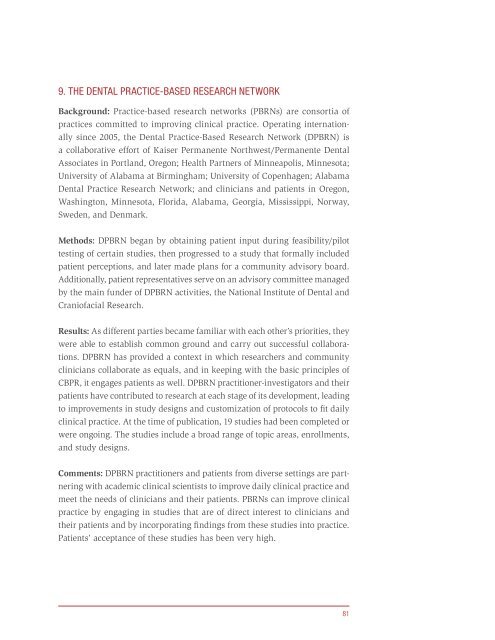Principles of Community Engagement (Second Edition)
Principles of Community Engagement (Second Edition)
Principles of Community Engagement (Second Edition)
You also want an ePaper? Increase the reach of your titles
YUMPU automatically turns print PDFs into web optimized ePapers that Google loves.
9. THE DENTAL PRACTICE-BASED RESEARCH NETWORK<br />
Background: Practice-based research networks (PBRNs) are consortia <strong>of</strong><br />
practices committed to improving clinical practice Operating internation-<br />
ally since 2005, the Dental Practice-Based Research Network (DPBRN) is<br />
a collaborative effort <strong>of</strong> Kaiser Permanente Northwest/Permanente Dental<br />
Associates in Portland, Oregon; Health Partners <strong>of</strong> Minneapolis, Minnesota;<br />
University <strong>of</strong> Alabama at Birmingham; University <strong>of</strong> Copenhagen; Alabama<br />
Dental Practice Research Network; and clinicians and patients in Oregon,<br />
Washington, Minnesota, Florida, Alabama, Georgia, Mississippi, Norway,<br />
Sweden, and Denmark<br />
Methods: DPBRN began by obtaining patient input during feasibility/pilot<br />
testing <strong>of</strong> certain studies, then progressed to a study that formally included<br />
patient perceptions, and later made plans for a community advisory board<br />
Additionally, patient representatives serve on an advisory committee managed<br />
by the main funder <strong>of</strong> DPBRN activities, the National Institute <strong>of</strong> Dental and<br />
Crani<strong>of</strong>acial Research<br />
Results: As different parties became familiar with each other’s priorities, they<br />
were able to establish common ground and carry out successful collaborations<br />
DPBRN has provided a context in which researchers and community<br />
clinicians collaborate as equals, and in keeping with the basic principles <strong>of</strong><br />
CBPR, it engages patients as well DPBRN practitioner-investigators and their<br />
patients have contributed to research at each stage <strong>of</strong> its development, leading<br />
to improvements in study designs and customization <strong>of</strong> protocols to fit daily<br />
clinical practice At the time <strong>of</strong> publication, 19 studies had been completed or<br />
were ongoing The studies include a broad range <strong>of</strong> topic areas, enrollments,<br />
and study designs<br />
Comments: DPBRN practitioners and patients from diverse settings are partnering<br />
with academic clinical scientists to improve daily clinical practice and<br />
meet the needs <strong>of</strong> clinicians and their patients PBRNs can improve clinical<br />
practice by engaging in studies that are <strong>of</strong> direct interest to clinicians and<br />
their patients and by incorporating findings from these studies into practice<br />
Patients’ acceptance <strong>of</strong> these studies has been very high<br />
81

















